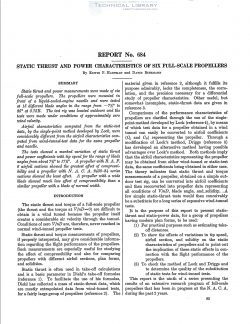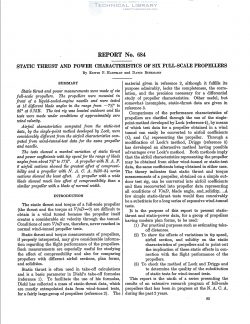naca-report-684

- Version
- 239 Downloads
- 1.29 MB File Size
- 1 File Count
- August 30, 2016 Create Date
- August 30, 2016 Last Updated
National Advisory Committee for Aeronautics, Report - Static Thrust and Power Characteristics of Six Full Scale Propellers

Static thrust and power measurements were made of six
full-scale propellers. The propellers were mounted in
front of a liguid—cooled—engine nacelle and were tested
at 15 difierent blade angles in the range from —7’}é° to
35° at 0.7512. The test rig was located outdoors and the
tests were made under conditions of approximately zero
wind velocity.
Airfoil characteristics computed from the static—test
data, by the single-point method developed by Lock, were
considerably difierent from the airfoil characteristics com-
puted from wind-tunnel—test data for the same propeller
and nacelle.
The tests showed a marked variation of static thrust
and power coeflicients with tip speed for the range of blade
anglesfrom about 7%o to 17%°. A propeller with R. A. F.
6 airfoil sections showed the greatest efiect of compressi-
bility and a propeller with N. A. 0. A. 2400—34 series
sections showed the least eject. A propeller with a wide
blade showed much less eject of compressibility than a
similar propeller with a blade of normal width.
The static thrust and torque of a full-scale propeller
(the thrust and the torque at V/nD=0) are difficult to
obtain in a wind tunnel because the propeller itself
creates a considerable air velocity through the tunnel.
Conditions of zero V/nD are, therefore, never reached in
normal wind—tunnel propeller tests.
Static thrust and torque measurements of propellers,
if properly interpreted, may give considerable informa-
tion regarding the flight performance of the propellers.
Such measurements are especially useful for studying
the effect of compressibility and also for comparing
propellers with different airfoil sections, plan forms,
and solidities.
Static thrust is often used in take-off calculations
and is a basic parameter in Diehl’s take-off formulas
(reference 1). To facilitate the use of his formulas,
Diehl has collected a mass of static—thrust data, which
are mostly extrapolated data from wind—tunnel tests,
for a fairly large group of propellers (reference 2).
| File | Action |
|---|---|
| naca-report-684 Static Thrust and Power Characteristics of Six Full Scale Propellers.pdf | Download |
Comment On This Post